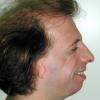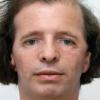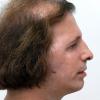ETIOLOGY - HEREDITY
It's about a syndrome with strong heredity. If one of the parents has this syndrome, then the children have a 50% chance to be born with the same syndrome. In many cases, however, it is a new mutation that is created during conception.
Almost recently genes that are responsible for this syndrome have been identified. Genetic defects are not detected in all cases.
MORPHOLOGICAL CHARACTERISTICS
The Treacher Collins syndrome appears the following morphological disorders which almost always affect both sides of the face symmetrically.
- The zygomatic area is hypoplastic with bone defects or/and the absence of cheekbone. In the same area, the lower eyelids have colobomas and abnormal hair growth of eyelashes.
- The ears flaps present various malformations, with frequent absence of the ear canal.
- The upper jaw may be hypoplastic and coexist with cleft palate.
- The lower jaw is hypoplastic and has a typical conformation that aggravates the malformation.
FUNCTIONAL PROBLEMS
The functional problems that accompany this syndrome are multiple and some of them need immediate treatment. These problems are the following:
- Breathing problems (obstructive apnea in a very high percentage)
- Eating difficulties
- Hearing problems (hearing loss in each ear due to abnormalities of the outer and middle ear, which conduct sound to the nerve endings)
- Intelligence is not affected by the Treacher Collins syndrome and it is usually normal.
SURGICAL TREATMENT - REHABILITATION
The infants with this syndrome should be evaluated soon by a Craniofacial team and their parents should be prepared for a prolonged period of rehabilitation.
- If there is marked respiratory distress, it is possible to be needed tracheostomy soon after birth, until providing a more permanent solution at a later time. Although in some centers it is applied distraction osteogenesis, though this method is not widely acceptable for newborns and its application is postponed for a later time.
- Sufficient food intake must be ensured and may be needed gavage or even through a gastrostomy tube to ensure adequate caloric intake and hydration for some time. The rule for the adequate feeding is the satisfactory weight gain of the newborn.
- The hearing should be evaluated immediately, and if necessary to be applied acoustics (osteophone) in order to be ensured the adequate hearing function.
- The repair of bone deformities as well as the soft tissues becomes at a later age according to the specific needs of each case.
- In general, the bone defects are completed with bone grafts that are usually taken from the skull while the soft tissues malformations are restored using flaps, muscle transfers and with skin grafts.
The dental occlusion and jaws disharmonies are restored usually with the cooperation of the orthodontist and surgeon during adolescence.
WHAT SHOULD NOT BE DONE
The medical acts that are often performed and which should be avoided are the following:
- Early effort for the reconstruction of flap ears. Their restoration is performed after the completion of the skeletal problems rehabilitation.
- Attempt of the ear canal incision, since it largely precludes the effective repair of skeletal abnormalities, and besides it usually doesn't give the desired results.
- Finally, the early application of computed tomography (CT) during the neonatal and infancy should be avoided except in special cases. This makes sense only when it is about to start the skeletal problems rehabilitation.





